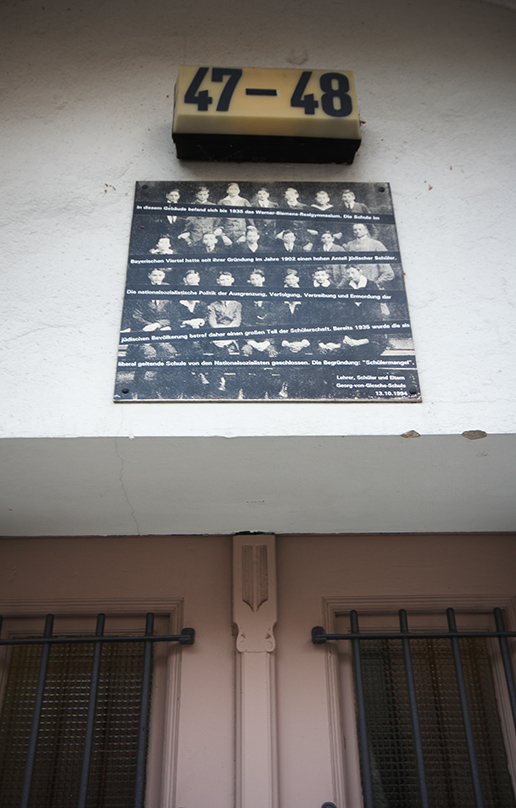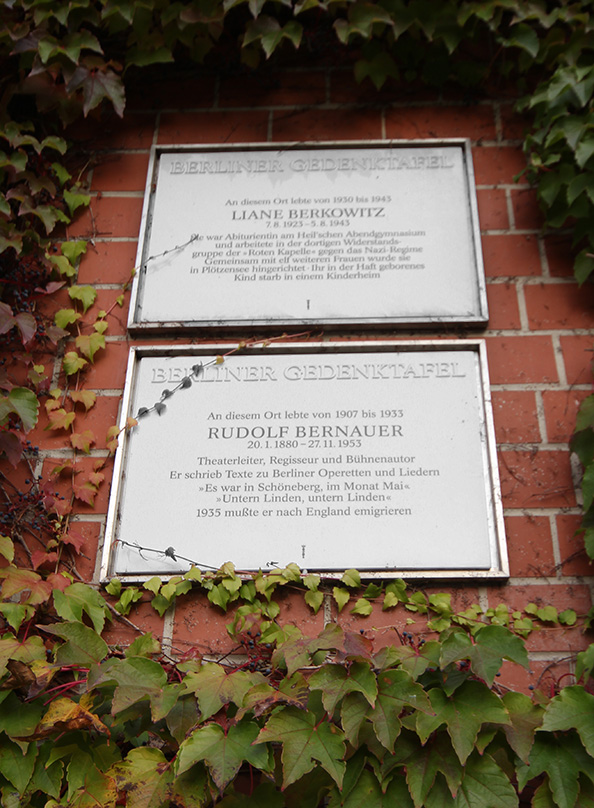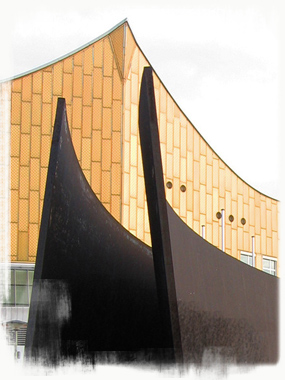Looking around Bayerischer Platz, nothing in the square initially stood out. Then we spotted the pictograph of a park bench against a bright green background. It was affixed to a lamppost and looked like a clue in a children’s board game.
But the reverse of the signboard indicated otherwise: “Juden dürfen am Bayerischen Platz nur die gelb markierten Siztbänke benutzen.” (“Jews may only use the yellow-marked benches on Bayerischer Platz.”)
So this was it, or rather one part of it. We had come to this quarter in Berlin’s Tempelhof-Schöneberg district in search of this unique decentralised memorial to the Jews persecuted during the Nazi era.
In the early 20th century, Jews made up 5.5 percent of the district’s residents, particularly in the upper-class residential area of Bayerisches Viertel (‘Bavarian Quarter’).
Among them were prominent residents including later-Nobel Prize winners Albert Einstein and writer Nelly Sachs, photographer Helmut Newton and social work reformer Alice Salomon.
When the Nazis took power in 1933, the district, and especially the quarter, started noticeably emptying of Jewish residents through forced migration, deportation (of whom a third were affected) and murder.
But it began with the abrogation of their rights, which the Nazis justified through the use of laws and regulations. The first were formulated in 1933 itself. They swelled in number until the very end of WWII in 1945.
Sixty years after the first law was devised, a memorial was set up in the Bayerisches Viertel “to remember the almost-forgotten history of this neighborhood .. (and become) a metaphor of the daily deprivation of rights and humiliation of Jews during the Nazi era”.
The memorial’s full title is Orte des Erinnerns im Bayerischen Viertel: Ausgrenzung und Entrechtung, Vertreibung, Deportation und Ermordung von Berliner Juden in den Jahren 1933 bis 1945 (Places of Remembrance in the Bayerisches Viertel: Exclusion and Disenfranchisement, Expulsion, Deportation and Murder of Berlin Jews from 1933 to 1945).
The brainchild of artist Renata Stih and art historian Frieder Schnock, it comprises 80 double-sided poster-sized signs attached to lampposts 3 m from the ground. These are scattered throughout the neighbourhood, particularly near public spaces like parks, kindergartens and churches.
These signs as metaphors are powerful.
On the one side, a visual: colourful, clear, eye-catching and immediately comprehensible. On the other, text in black and white, more complex and layered, inviting, even forcing deliberation.
The appearance of cheerfulness and innocence is a front for the chilling meaning of what is literally behind.
In this way the Nazi misappropriation of what laws ostensibly stand for – justice, correctness and legitimacy – masks what these anti-Semitic laws actually stood for: injustice, transgression and persecution.
Not all texts comprise simplified versions of the Nazi-era regulations and laws. Quotes were also included.
One example we saw near a post office was an extract from a letter: “Nun ist es soweit, morgen muß ich fort u. das trifft mich natürlich schwer, (…) Ich werde Dir schreiben …Vor der Deportation, 16.1. 1942.” (“The time has come, tomorrow I must leave and that of course is very difficult, (…) I will write to you … Before the deportation, 16.1. 1942.”)
The use of these everyday signs and the locating of them in a regular neighbourhood forces the question that is asked till today: how did non-Jews allow the rights of their well-assimilated Jewish neighbours to be eroded, their lives ruined and then taken away, right before their eyes?
Our experience of this memorial 20 years after it was put up, suggests a little of how this could have happened.
At first, we looked at each sign carefully, read its text and let its disturbing significance sink in.
But as we walked through the quarter, our experience of the memorial changed. Each time we came across a pictograph, we would recognise and accept it as a piece of the memorial. From the pictures, we would get a vague idea of what each one stood for.
However, the text behind the image – what more its meaning and moral significance – would through a process of sheer attrition, become too much to work out.
We were swamped by the sheer number and outrageousness of each sign. We could not take in – or on – more than a handful of the 80 signs.
Was this a process Berliners in Nazi Germany went through as yet another anti-Jewish law came into being, yet another facet of Jewish neighbours’ lives destroyed and finally, their presence annihilated?
Did they come to accept it because the meaning and moral significance of it simply became too much to work out?
As a corollary to that, and fast forwarding to the present, I could not help wondering what the local residents thought of the signs being on their front yards.
Had the memorial also become for them invisible, just another part of the neighbourhood landscape but for the odd tourist wandering through?
It was certainly not the case when the memorial was first put up in 1993.
Then, residents protested vehemently, according to academic Caroline Wiedmer in her essay on the memorial, ‘Remembrance in Schöneberg’.
This even led to changes to the original memorial. Residents wanted the addition of both an information panel indicating the context of the signs, and the dates of when each regulation or legislation was formulated.
Without these dates, the signs would have effectively blurred the lines between past and present “even as it suggests that today’s society was vulnerable to similar affront”.
Still, none of this takes away the memorial’s power. This is more so because the lead in this initiative was taken by a state institution: the Berlin locality of Schöneberg.
This is a critical shouldering of responsibility in light of the fact that the crimes against the Jews were perpetrated by state institutions at every level, down to very local levels.
According to Wiedmer, this memorial is part of efforts that began in 1983 by the Schöneberg authorities in its Vergangenheitsaufarbeitung (working through the past) to research the lives and fates of its many former Jewish residents.
The first result was the establishing of an exhibition in a public building, the Rathaus Schöneberg (town hall).
Called ‘Wir waren Nachbarn‘ (‘We were Neighbours’), it is a collection of stories and memories, including 150 detailed biographies, that are based on accounts and documentation by surviving witness and their descendants from all over the world.
Using multimedia, it aims to portray not merely victims but individuals “embedded in their family histories and in daily social environments”. It is now permanently installed at the town hall and continues to grow.
Perusing the biographical albums, I was surprised to spot Billy Wilder’s. Surely it could not be the Billy Wilder of ‘Sunset Boulevard’ and various Marilyn Monroe vehicles? Indeed it was. Born Samuel Wilder in Austria, he had lived in the Bayerisches Viertel and had migrated to the USA in 1934, eventually becoming an award-winning filmmaker.
In any case, back in the 1980s, it was the Vergangenheitsaufarbeitung effort of one researcher which led to the discovery that over 6,000 Jews from the Bayerisches Viertel had been deported. Schöneberg authorities decided then to erect a memorial in the quarter.
The Stih & Schnock memorial design was the unanimous winner of a competition held. Today, besides walking through the streets, visitors can view all 80 signs of that memorial on three large maps in various parts of the Bayerisches Viertel.
Besides these memorials, though, we found that Schöneberg was full of commemorations of former Jewish residents. Our short stroll revealed memorial tablets, Stolpersteine, a GDR-era monument to a destroyed synagogue and tributes to Nazi resistance efforts by Jews and non-Jews alike.
Startlingly, in the midst of all this, we encountered election posters by the extreme right wing National Democratic Party (NPD). They had hung these on lampposts too, but at least had the sense not to use lampposts which hosted the memorial signboards.
It was unnerving to see them. But we got some comfort from the fact that some had been defaced with paint and people had also posted anti-Nazi stickers on walls nearby.
Still, Stih & Schnock were right: today’s society is vulnerable to similar affront. ω
Photo Gallery


Next photo


Next photo


Next photo


Next photo


Next photo


Next photo


Next photo


Next photo


Next photo


Links
Further Reading:
Artists Stih & Shnock’s homepage on the Places of Remembrance memorial has essays on the work, including a discussion of it by academic Caroline Wiedmer (‘Remembrance in Schöneberg’, 1995).
There are also links to images of two of their lightboxes installed at Princeton University, which map out the Bayerisches Viertel in 1933 and 1993, all the signs that make up the memorial and 1993 interviews with locals.
The homepage of the ‘Wir waren Nachbarn’ (‘We were Neighbours’) exhibition at the Rathaus Schöneberg has details about the exhibition including the rotating annual themes and brief biographies (in German).
Experienced: 22.10.2011 || Recounted: 28.11.2014
If you see this after your page is loaded completely, leafletJS files are missing.



